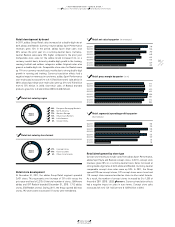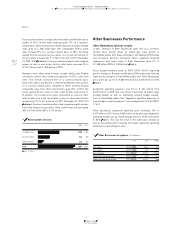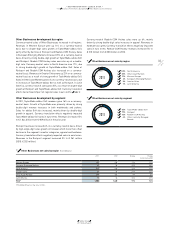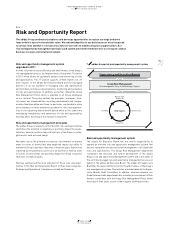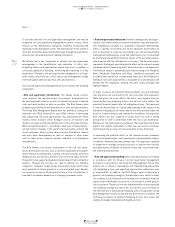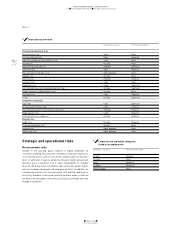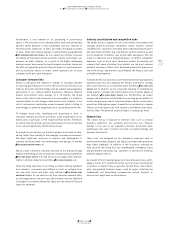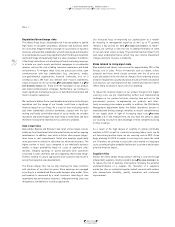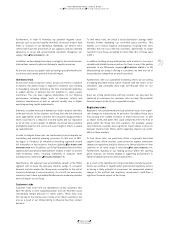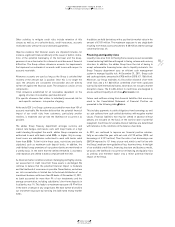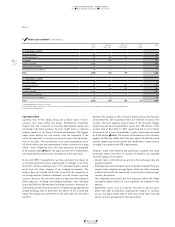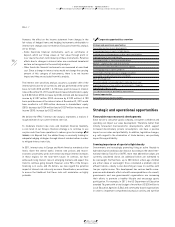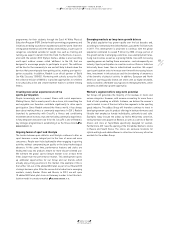Reebok 2011 Annual Report Download - page 153
Download and view the complete annual report
Please find page 153 of the 2011 Reebok annual report below. You can navigate through the pages in the report by either clicking on the pages listed below, or by using the keyword search tool below to find specific information within the annual report.
adidas Group
2011 Annual Report
GROUP MANAGEMENT REPORT – FINANCIAL REVIEW
149
2011
03.4 Risk and Opportunity Report Strategic and operational risks
Furthermore, a core element of our positioning in performance
sports is the utilisation of an extensive global event and partnership
portfolio where demand is more predictable and less sensitive to
macroeconomic influences. In 2012, we expect the global economy
to grow, albeit with varying degrees of performance geographically
SEE SUBSEQUENT EVENTS AND OUTLOOK, P. 163
. As a result, we continue to assess
the likelihood that adverse macroeconomic events could impact our
business as likely. However, as a result of the highly challenging
macroeconomic environment in many European countries, Japan and
the USA, we regard the potential financial impact of macroeconomic
and socio-political factors as major, which represents an increase
compared to the prior year evaluation.
Consumer demand risks
Failure to anticipate and respond to changes in consumer demand
for sporting goods products is one of the most serious threats to our
industry. Consumer demand changes can be sudden and unexpected,
particularly in our fashion-related businesses. Because industry
product procurement cycles average 12 to 18 months, the Group
faces a risk of short-term revenue loss in cases where it is unable to
respond quickly to such changes. Even more critical, however, is the
risk of continuously overlooking a new consumer trend or failing to
acknowledge its potential magnitude over a sustained period of time.
To mitigate these risks, identifying and responding to shifts in
consumer demand as early as possible is a key responsibility of our
brands and, in particular, of the respective Risk Owners. Therefore,
we utilise extensive primary and secondary research tools as outlined
in our risk and opportunity identification process.
As a leader in our industry, our brand strategies are focused on influ-
encing rather than reacting to the changing consumer environment.
We invest significant resources in research and develop ment to
innovate and bring fresh new technologies and designs to market
SEE RESEARCH AND DEVELOPMENT, P. 95
.
We also seek to enhance consumer demand for our brands through
extensive marketing, product and brand communication programmes
SEE GLOBAL BRANDS STRATEGY, P. 68
. And we focus on supply chain improve-
ments to shorten production lead times
SEE GLOBAL OPERATIONS, P. 90
.
Given the broad spectrum of our Group’s product offering, feedback
from retailers, consumers and athletes as well as evidence from
our own-retail stores and other early indicators
SEE INTERNAL GROUP
MANAGEMENT SYSTEM, P. 114
, we view the risk from consumer demand shifts
as unchanged versus the prior year. We therefore rate the likelihood
of changes in consumer demand as likely, and the potential financial
impact as moderate.
Industry consolidation and competition risks
The adidas Group is exposed to risks from market consolidation and
strategic alliances amongst competitors and/or retailers, intense
competition for consumers from both well-established industry peers
and new market entrants (e.g. new brands, vertical retailers) as well
as the expansion of retailers’ own private label businesses. This can
result in a reduction of our bargaining power, or harmful competitive
behaviour such as price wars. Abnormal product discounting and
reduced shelf space allocation from retailers are the most common
potential outcomes of these risks. Sustained promotional pressure in
one of the Group’s key markets could threaten the Group’s sales and
profitability development.
To moderate this risk, we are also committed to maintaining a regionally
balanced sales mix and adapting the Group’s distribution strategy
with a particular focus on controlled space initiatives
SEE GLOBAL SALES
STRATEGY, P. 62
. In addition, we are constantly investing in strengthening
brand equity to increase the attractiveness and consumer appeal of
our products
SEE GLOBAL BRANDS STRATEGY, P. 68
. Furthermore, we expect
merger and acquisition activity within the sporting goods industry to
remain buoyant given robust corporate balance sheets and business
projections. Although we expect competition in our industry to remain
intense, we now regard risks from industry consolidation and compe-
tition as likely. The potential financial impact is assessed as major.
Hazard risks
The adidas Group is exposed to external risks such as natural
disasters, epidemics, fire, accidents and malicious acts. Physical
damage to our own or our suppliers’ premises, production units,
warehouses and stock in transit can lead to property damage and
business interruption.
These risks are mitigated by loss prevention measures such as
working with reliable suppliers and logistics providers who guarantee
high safety standards. In addition to the insurance coverage we
have secured, the Group has also implemented contingency plans
and preventative measures (e.g. sprinklers in facilities) to minimise
potential negative effects.
As a result of the increasing frequency of natural disasters (e.g. earth-
quakes, floods, etc.) around the world, we now assess the potential
occurrence of hazard risks as possible. Should those risks materi-
alise, the potential financial impact could be major, reflecting the
fundamental and devastating consequences natural disasters or
terrorist acts might have on our business.




